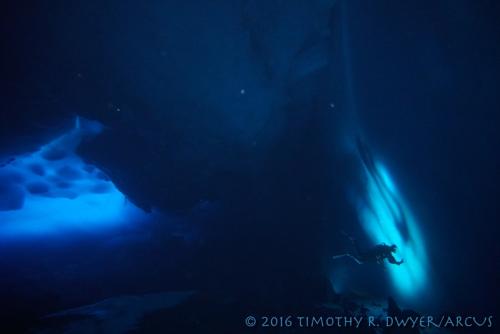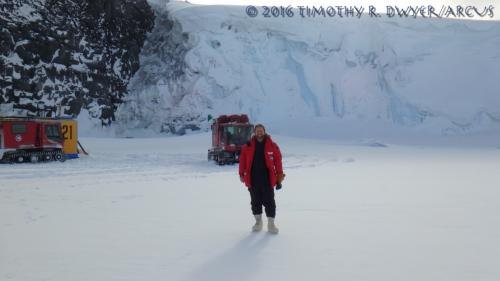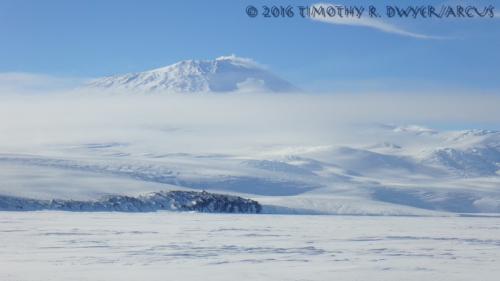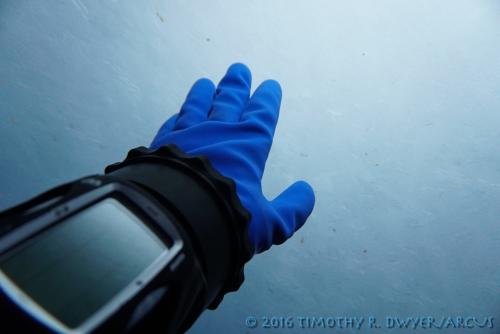 Taking a break from sea spider collections, Steve Lane swims up to the grounding line of the Barne Glacier, 50ft/15m underwater.
Taking a break from sea spider collections, Steve Lane swims up to the grounding line of the Barne Glacier, 50ft/15m underwater.
I touched a glacier for the first time the other day. The river of ice flowing down the slopes of Mt. Erebus and out into McMurdo Sound near Cape Barne is known as the Barne Glacier. Where it runs into the ocean, it's close to 30m/100ft tall and towers in a craggy, fissure-filled wall over our dive hut near Cape Barne. Below the sea ice, it slides down into the black, much farther than I can swim or see, or would even want to. Next to the underwater boulder field deposited by the freeze/thaw cycle of the basaltic cliffs above, the subtidal Barne Glacier forms an unbroken wall of white, curling up overhead and creating a dark and cavernous chamber at the edge of the deep.
 Covering the northwestern slope of Mt Erebus, the Barne Glacier towers over our dive hut and Pisten Bully as it connects with McMurdo Sound.
Covering the northwestern slope of Mt Erebus, the Barne Glacier towers over our dive hut and Pisten Bully as it connects with McMurdo Sound.
Sea ice and glacial ice are formed by two entirely different processes. The "fast ice" under which we dive is frozen sea water, cooled to the point of freezing and expelling much of its salt in the process. In McMurdo Sound, the ice "held fast" in place against the land creates a flat, unbroken horizon of white that will eventually begin to melt, splitting up at the height of the austral summer and blowing North, out into the Ross Sea. The fast ice in McMurdo Sound thickens to about 8ft/2.5m, but can reach thicknesses of 15ft/5m under the right conditions. Despite the hazards of cracks and territorial seals, fast sea ice serves as highway for both penguin and PistenBully, creating an open terrain that allows for easy travel, during part of the year at least.
 The glacier's substantial height above sea level seems insignificant when compared to the volcano on which it formed.
The glacier's substantial height above sea level seems insignificant when compared to the volcano on which it formed.
Glacial ice is the product of hundreds of thousands of years of snowfall, compacting and freezing solid, rising to great heights over the land, slowly flowing into the sea and even weighing down the Earth's crust at the same time. Glacial ice is formed from fresh water and preserves a record of the conditions under which it formed. The large glaciers that sit on land are known as ice sheets; the edges of glaciers that flow into the oceans and float upon them are known as ice shelves. They can be hundreds, or even thousands of yards/meters thick and by breaking off, or "calving," into the sea, give birth to giant icebergs. In the Ross Sea, slightly warmer water from deep down melts the base of these shelves where they contact the bedrock underwater - the grounding line. In swimming up to the grounding line of the Barne Glacier, I had the profound experience of putting my gloved hand on half a million years of the planet's story before it eventually breaks free and drifts into the Ross Sea.
 Touching a glacier for the very first time.
Touching a glacier for the very first time.
